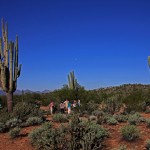Underground City – Beijing, China (03.04.16)
Like a secret maze, Beijing’s Underground City is probably the world’s most impressive bomb shelter. Covering an area of something over 85sq kms, it spreads like a spider’s web, from the heart of central Beijing’s Old City to the outer Western Hills regions, 28 kms away.

At the height of the Sino-Soviet Cold War (1969-79) the residents of central Beijing, fearing an imminent nuclear or bio-chemical attack from Russia, took to digging underground escape routes by hand. Although there is no authoritative information confirming how spread out the tunnels are, the official line was that up to six million Beijing residents could, in case of attack, escape to the outer city limits. In addition it was believed that up to 300,000 residents could be accommodated below ground for an indefinite period.

Descending down into Beijing Underground City, 1985.
There are reportedly over a thousand air-raid structures. In addition to store rooms, bedding enclaves, shops, restaurants, schools, factories, clinics and warehouses, the local residents built an intricate ventilation system. And all this predominantly by hand with shovels, kitchen spoons and equipment more geared to grooming or gardening than tunnel-digging. Initially encouraged by Chairman Mao, the tunnel system had over ninety secret entrances spread around the old city through sliding shop floors, street market hatches and busy market alleyways.

Forbidden City 1985 – Underground City tunnels running under Beijing’s old city region.
Escorted by a local shop keeper in 1985, I was lucky enough to disappear down one of the shop floor tunnel entrances, and to briefly explore the tunnel maze below. Which aside from feeling like a character out of a James Bond film, I found extraordinary as we were immediately below ground, under this most historical of city centres, only metres away from Tiananmen Square, The Forbidden City and Temple of Heaven.
As these 1985 photos show, life above ground continued then, as it has ever since, with the bulk of the mid-1980s population totally unaware of what lay below.

Underground City sleeping area.
Officially opened as a tourist attraction in 2000, it subsequently closed in 2008 for renovation. There has been little to no promotion ever since.
In 1985 when I visited the tunnels it was another era, and enormous changes have taken place throughout the country since then. I decided to post this blog on hearing how popular China’s new Disneyland Shanghai appears to be. This week, as Europe’s Disneyworld Paris suffers from a western world’s changing aspirations, Disneyland Shanghai’s opening ticket sales sold out within minutes of going online at midnight last Monday.
It’s a far cry from what to my mind is one of China’s most impressive potential tourist attractions. Whether the authorities will embrace their capital’s Underground City as a mainstream attraction or not, I am certain that international tourists of a more discerning nature would find it more interesting than breakfast with Mickey Mouse.

Beijing Opera (1985) – traditional tourist attraction, located meters above Underground City.
As things stand, nowadays local interest in the tunnels is driven more by necessity than curiosity, more by the mass migration from China’s rural areas, than by domestic tourism interests, or imminent threats of war.
As Beijing’s population heads past 21 million, this most extraordinary of underground tunnel systems has enjoyed a new lease of life. A new unofficial community of residents, known as the Rat Tribe, have taken to living in the underground bomb-shelter network to escape soaring rental rates above ground.
Certainly we at Nomadic Thoughts look forward to offering trips through Beijing’s fascinating sliding floors and trap doors.

Secret sliding shop floor, leading to Underground City.

Beijing ladies 1985.

Chairman Mao overlooking Tiananmen Square, 1985.

Underground City store room, 1985.

Hall of the People, 1985 – located in the heart of Underground City entrance network areas.

Old Beijing Beijing Bicycle park, 1985.

Underground City shop, 1985.

Temple of Heaven, 1985.

Beijing acrobats, 1985 – performing in heart of old city, above Underground City tunnel network.

Looking up into a shop from Underground City entrance stairway.

Beijing chalk notice, 1985.

Looking across at, and down into, Forbidden City Beijing – 1985.








